一般过去时 学案
一般过去时教案设计

一般过去时优秀教案设计一、教学目标1. 让学生掌握一般过去时的概念和用法。
2. 能够正确运用一般过去时描述过去发生的事情。
3. 提高学生的英语听说读写能力。
二、教学内容1. 一般过去时的概念和构成。
2. 一般过去时的用法和注意事项。
3. 一般过去时的练习和应用。
三、教学重点1. 一般过去时的概念和构成。
2. 一般过去时的用法和注意事项。
四、教学难点1. 一般过去时的构成和用法。
2. 正确运用一般过去时描述过去发生的事情。
五、教学方法1. 情境教学法:通过设置情境,让学生在实际语境中学习和运用一般过去时。
2. 任务型教学法:通过完成任务,让学生在实践中掌握一般过去时的用法。
3. 交际式教学法:通过小组讨论和角色扮演,提高学生的口语表达能力。
【课堂导入】教师通过提问引导学生思考过去发生的事情,激发学生对一般过去时的兴趣。
【新课讲解】1. 教师讲解一般过去时的概念和构成。
2. 教师举例说明一般过去时的用法和注意事项。
【练习巩固】1. 学生分组进行角色扮演,运用一般过去时描述过去发生的事情。
2. 学生完成一般过去时的练习题。
【拓展应用】1. 学生分组讨论,用一般过去时编写小故事。
2. 学生展示自己的作品,大家共同评价。
【课堂小结】教师总结本节课的学习内容,强调一般过去时的用法和注意事项。
【课后作业】1. 学生复习一般过去时的用法。
2. 学生完成课后练习题。
六、教学评价1. 通过课后作业和练习题检查学生对一般过去时的掌握程度。
2. 通过课堂表现和小组讨论评价学生的口语表达能力。
3. 通过学生编写的小故事评价学生的综合运用能力。
七、教学拓展1. 引导学生运用一般过去时描述自己的经历,提高学生的自我表达能力。
2. 组织学生进行一般过去时的写作练习,提高学生的写作能力。
3. 邀请家长参与课堂活动,增进家长对学校教学的了解和支持。
八、教学反思1. 教师在课后对自己的教学进行反思,总结教学过程中的优点和不足。
2. 教师根据反思结果调整教学方法,以提高教学效果。
全英文一般过去时教案
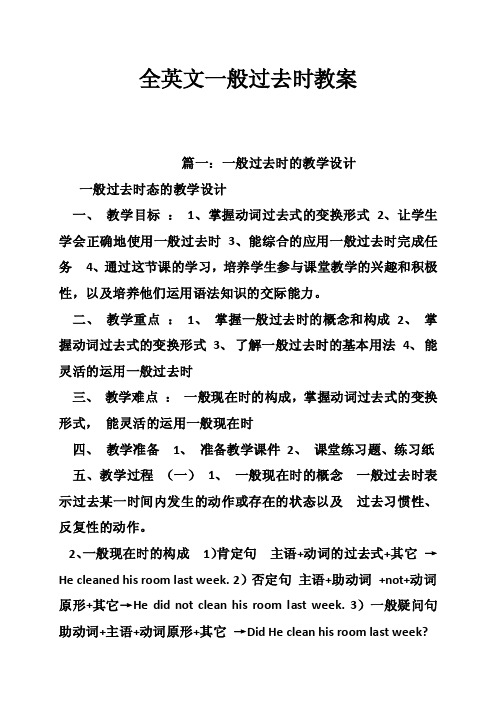
全英文一般过去时教案篇一:一般过去时的教学设计一般过去时态的教学设计一、教学目标:1、掌握动词过去式的变换形式2、让学生学会正确地使用一般过去时3、能综合的应用一般过去时完成任务4、通过这节课的学习,培养学生参与课堂教学的兴趣和积极性,以及培养他们运用语法知识的交际能力。
二、教学重点:1、掌握一般过去时的概念和构成2、掌握动词过去式的变换形式3、了解一般过去时的基本用法4、能灵活的运用一般过去时三、教学难点:一般现在时的构成,掌握动词过去式的变换形式,能灵活的运用一般现在时四、教学准备1、准备教学课件2、课堂练习题、练习纸五、教学过程(一)1、一般现在时的概念一般过去时表示过去某一时间内发生的动作或存在的状态以及过去习惯性、反复性的动作。
2、一般现在时的构成1)肯定句主语+动词的过去式+其它→He cleaned his room last week. 2)否定句主语+助动词+not+动词原形+其它→He did not clean his room last week. 3)一般疑问句助动词+主语+动词原形+其它→Did He clean his room last week?3、动词过去式的变化是以动词后加ed表示的,①一般情况词尾加-ed look→looked ②以不发音e结尾的动词,在词尾直接加ed live→lived③以“辅音字母+y ”结尾的动词变y为i,再加-ed study→studiedtry→tried ④以重读闭音节(即辅音+元音+辅音)结尾,末尾只有一个辅音字母的动词,要先双写这个辅音字母后,再加ed stop→stoppedplan→planned ⑤不规则动词的过去式需特殊记忆am(is) →was are→were go→went come→came 等4、一般过去时的基本用法一般过去时表示过去某个时间发生的动作或存在的状态,常和表示过去的时间状语连用。
一般过去时也表示过去经常或反复发生的动作。
初中英语一般过去时整册教案

初中英语一般过去时整册教案一、教学目标1. 让学生掌握一般过去时的概念和用法。
2. 能够运用一般过去时描述过去发生的事情。
3. 学会一般过去时的动词变化规则。
4. 提高学生的英语听说读写能力。
二、教学内容1. 第一课时:一般过去时的概念和用法教学重点:理解一般过去时的概念,掌握一般过去时的基本结构。
教学难点:一般过去时的动词变化规则。
2. 第二课时:一般过去时的动词变化规则教学重点:掌握一般过去时的动词变化规则。
教学难点:不规则动词的变化。
3. 第三课时:一般过去时的句子构建教学重点:学会如何构建一般过去时的句子。
教学难点:过去时间的表达方式。
4. 第四课时:一般过去时的听力练习教学重点:提高学生对一般过去时的听力理解能力。
教学难点:根据语境判断过去时。
5. 第五课时:一般过去时的口语练习教学重点:提高学生对一般过去时的口语表达能力。
教学难点:正确运用一般过去时描述过去的事情。
三、教学方法1. 情境教学法:通过设定情境,让学生在实际语境中学习一般过去时。
2. 任务型教学法:通过完成具体任务,让学生实践一般过去时的运用。
3. 互动式教学法:引导学生积极参与课堂活动,提高学生的参与度和积极性。
四、教学评价1. 课后作业:检查学生对一般过去时的理解和运用情况。
2. 课堂表现:观察学生在课堂活动中的参与度和表现。
3. 单元测试:评估学生对一般过去时的掌握程度。
五、教学资源1. 教材:人教版《英语》八年级上册。
2. 课件:一般过去时的相关课件和教学素材。
3. 视频资源:一般过去时的相关教学视频。
4. 练习册:配套练习册和相关练习题。
六、第六课时:一般过去时的阅读理解教学目标:1. 让学生通过阅读理解练习,进一步巩固一般过去时的用法。
2. 提高学生的阅读理解能力,培养学生运用一般过去时分析文本的能力。
教学内容:选取一篇涉及一般过去时的阅读材料。
通过阅读理解练习,让学生在具体语境中运用和理解一般过去时。
教学方法:引导学生进行预测、扫读和细读,以理解文本内容。
初中英语一般过去时教案

初中英语一般过去时教案教学目标:1. 理解并掌握一般过去时的概念。
2. 学会一般过去时的句子结构及使用方法。
3. 掌握一般过去时的规则变化和不规则变化。
教学重点:1. 一般过去时的基本概念和用法。
2. 规则动词的过去式变化规则。
教学难点:1. 不规则动词的过去式形式及用法。
教学准备:1. 教科书。
2. 活动板书工具。
3. 单词卡片和图片。
教学过程:一、导入(5分钟)教师可以通过出示一些图片或单词卡片,让学生回忆出过去发生的事情,并用一般过去时来描述这些事情。
二、介绍一般过去时(5分钟)教师向学生介绍一般过去时的定义和用法,说明一般过去时用于描述过去发生的事情或状态。
三、规则动词的过去式变化(15分钟)1. 教师出示一些规则动词的单词卡片,让学生一一念出来,并帮助他们找出规律,即加上-ed或-d。
2. 教师板书规则动词的过去式变化规则,并让学生补充例子。
四、不规则动词的过去式变化(15分钟)1. 教师出示一些不规则动词的图片或单词卡片,让学生尝试猜测它们的过去式并进行讨论。
2. 教师向学生解释这些不规则动词的过去式变化形式,并帮助他们记忆,并提供一些例子。
五、练习和应用(15分钟)1. 教师出示一些句子,让学生用一般过去时改写句子,并进行练习。
2. 学生之间进行对话练习,使用一般过去时来描述过去的经历或活动。
六、总结归纳(5分钟)教师与学生一起总结一般过去时的用法,并梳理规则动词和不规则动词的过去式变化规律。
教学延伸:1. 让学生用一般过去时写一篇日记,描述他们过去的一天或周末。
2. 给学生一个口头任务,让他们用一般过去时描述自己最喜欢的一本书、一部电影或一次旅行等。
一般过去时教案模板范文
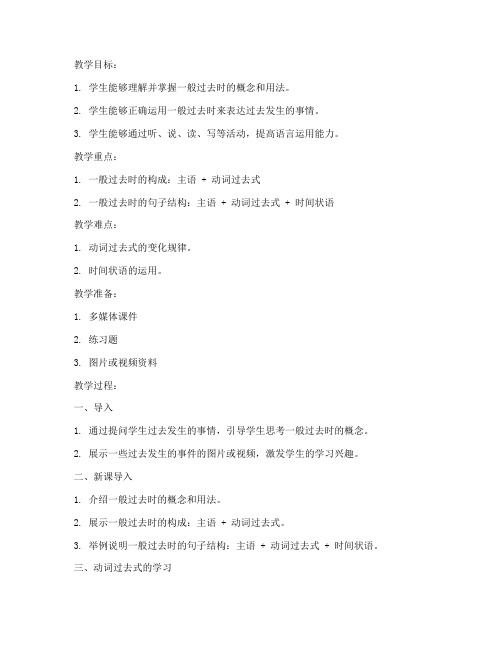
教学目标:1. 学生能够理解并掌握一般过去时的概念和用法。
2. 学生能够正确运用一般过去时来表达过去发生的事情。
3. 学生能够通过听、说、读、写等活动,提高语言运用能力。
教学重点:1. 一般过去时的构成:主语 + 动词过去式2. 一般过去时的句子结构:主语 + 动词过去式 + 时间状语教学难点:1. 动词过去式的变化规律。
2. 时间状语的运用。
教学准备:1. 多媒体课件2. 练习题3. 图片或视频资料教学过程:一、导入1. 通过提问学生过去发生的事情,引导学生思考一般过去时的概念。
2. 展示一些过去发生的事件的图片或视频,激发学生的学习兴趣。
二、新课导入1. 介绍一般过去时的概念和用法。
2. 展示一般过去时的构成:主语 + 动词过去式。
3. 举例说明一般过去时的句子结构:主语 + 动词过去式 + 时间状语。
三、动词过去式的学习1. 讲解动词过去式的变化规律,以规则动词和非规则动词为例。
2. 通过表格展示规则动词和非规则动词的过去式变化。
3. 进行动词过去式的练习,让学生自主完成。
四、时间状语的运用1. 介绍时间状语在一般过去时句子中的运用。
2. 展示一些常见的时间状语,如:yesterday, last week, two days ago等。
3. 通过例句让学生理解时间状语的运用。
五、综合练习1. 让学生根据所学知识,完成一些听、说、读、写练习。
2. 分组讨论,让学生运用一般过去时进行口语交流。
六、课堂小结1. 回顾本节课所学内容,强调一般过去时的概念、构成和用法。
2. 总结动词过去式变化规律和时间状语的运用。
七、课后作业1. 完成课后练习题,巩固所学知识。
2. 搜集一些过去发生的事件,用一般过去时进行描述。
教学反思:1. 关注学生的学习效果,及时调整教学策略。
2. 注重培养学生的语言运用能力,提高学生的口语表达能力。
3. 创设丰富的教学情境,激发学生的学习兴趣,提高课堂氛围。
初中英语一般过去时教案
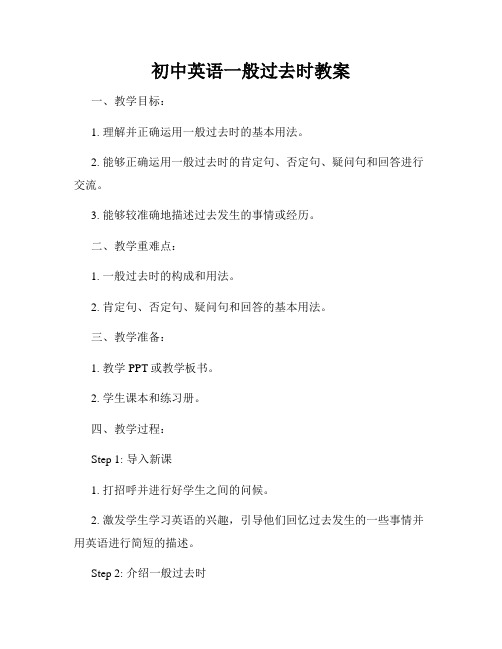
初中英语一般过去时教案一、教学目标:1. 理解并正确运用一般过去时的基本用法。
2. 能够正确运用一般过去时的肯定句、否定句、疑问句和回答进行交流。
3. 能够较准确地描述过去发生的事情或经历。
二、教学重难点:1. 一般过去时的构成和用法。
2. 肯定句、否定句、疑问句和回答的基本用法。
三、教学准备:1. 教学PPT或教学板书。
2. 学生课本和练习册。
四、教学过程:Step 1: 导入新课1. 打招呼并进行好学生之间的问候。
2. 激发学生学习英语的兴趣,引导他们回忆过去发生的一些事情并用英语进行简短的描述。
Step 2: 介绍一般过去时1. 出示一般过去时的定义和用法的PPT或写在黑板上。
2. 解释一般过去时的基本构成规则:动词过去式的变化。
3. 用几个常见的动词过去式变化的例子来让学生掌握规律。
Step 3: 基本句型讲解和练习1. 针对肯定句、否定句和疑问句的句型结构进行讲解和示范。
2. 引导学生进行一些口头练习,巩固所学的句型。
Step 4: 句型转换训练1. 提供一些句子让学生进行相应的转换练习,如将肯定句转为否定句、否定句转为肯定句等。
2. 让学生两两搭档进行练习,并鼓励他们进行口头表达。
Step 5: 阅读理解练习1. 分发一篇关于过去发生的事情的阅读材料。
2. 让学生独立阅读材料并回答相关问题。
3. 收集学生的回答并进行讨论,纠正他们的错误,帮助他们更好地理解过去时的用法。
Step 6: 语法练习1. 分发练习册的相关练习题,让学生进行语法练习。
2. 实施巡回检查学生的答案,并进行讲解。
Step 7: 拓展活动1. 在教室里贴上一些图片,让学生观察并描述所看到的图片中的过去发生的事情。
2. 学生之间进行合作互动,相互分享他们观察到的过去事态的描述。
Step 8: 总结与作业布置1. 对本节课进行总结,强调一般过去时的基本用法。
2. 布置相应的作业,要求学生用一般过去时完成练习册中的相关练习。
一般过去时复习课教案
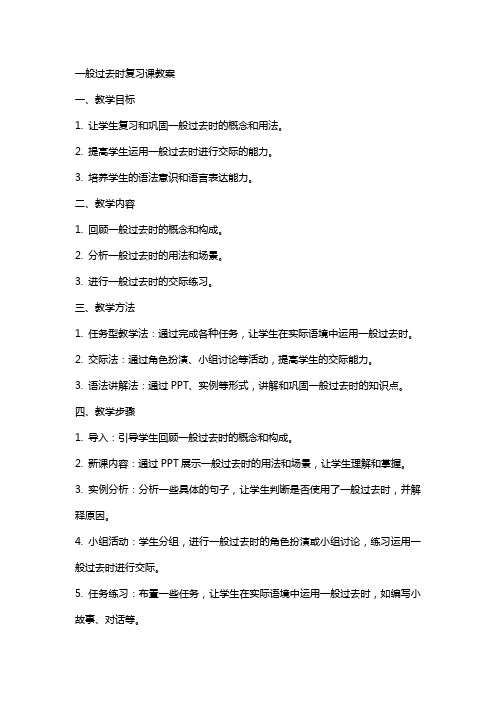
一般过去时复习课教案一、教学目标1. 让学生复习和巩固一般过去时的概念和用法。
2. 提高学生运用一般过去时进行交际的能力。
3. 培养学生的语法意识和语言表达能力。
二、教学内容1. 回顾一般过去时的概念和构成。
2. 分析一般过去时的用法和场景。
3. 进行一般过去时的交际练习。
三、教学方法1. 任务型教学法:通过完成各种任务,让学生在实际语境中运用一般过去时。
2. 交际法:通过角色扮演、小组讨论等活动,提高学生的交际能力。
3. 语法讲解法:通过PPT、实例等形式,讲解和巩固一般过去时的知识点。
四、教学步骤1. 导入:引导学生回顾一般过去时的概念和构成。
2. 新课内容:通过PPT展示一般过去时的用法和场景,让学生理解和掌握。
3. 实例分析:分析一些具体的句子,让学生判断是否使用了一般过去时,并解释原因。
4. 小组活动:学生分组,进行一般过去时的角色扮演或小组讨论,练习运用一般过去时进行交际。
5. 任务练习:布置一些任务,让学生在实际语境中运用一般过去时,如编写小故事、对话等。
6. 总结与反馈:对学生的表现进行点评,指出错误并给予改正,总结一般过去时的关键知识点。
五、教学评价1. 课堂参与度:观察学生在课堂活动中的积极参与程度和表现。
2. 任务完成情况:评估学生在任务练习中的表现,包括语法正确性、表达流畅性等。
3. 学生互评:鼓励学生互相评价,共同提高语言表达能力。
教学资源:PPT、实例句子、任务练习材料等。
教学时间:45分钟注意事项:1. 确保学生掌握一般过去时的概念和构成。
2. 注重培养学生的交际能力,鼓励开口说英语。
3. 在教学过程中,注重激发学生的兴趣和积极性。
六、教学拓展1. 通过视频或故事,让学生了解一般过去时在实际生活中的应用。
2. 介绍一些常用的一般过去时的表达方式,如“yesterday”、“last week”等。
3. 引导学生关注一般过去时在语境中的变化,如时态、语态等。
七、课堂活动1. 进行一般过去时的接龙游戏,让学生在轻松的氛围中巩固知识。
一般过去时复习教案

一般过去时复习教案一、教学目标1. 让学生复习和掌握一般过去时的构成和用法。
2. 提高学生运用一般过去时进行交流的能力。
3. 培养学生的语法意识和语言表达能力。
二、教学内容1. 一般过去时的构成:动词过去式。
2. 一般过去时的用法:描述过去发生的动作或状态。
三、教学重点与难点1. 教学重点:一般过去时的构成和用法。
2. 教学难点:动词过去式的变化规律。
四、教学方法1. 任务型教学法:通过完成各种任务,让学生在实践中学习和运用一般过去时。
2. 情景教学法:创设各种情景,让学生在真实的语境中体会和运用一般过去时。
五、教学步骤1. 导入:引导学生回顾一般过去时的概念和构成。
2. 新课内容:讲解一般过去时的用法和动词过去式的变化规律。
3. 实例分析:分析一些句子,让学生判断是否使用了一般过去时,并解释原因。
4. 小组讨论:学生分组,讨论一般过去时在实际生活中的应用,分享彼此的看法。
5. 任务练习:设计一些练习题,让学生运用一般过去时进行描述。
6. 情景模拟:创设一些情景,让学生在模拟对话中运用一般过去时。
8. 作业布置:布置一些有关一般过去时的家庭作业,让学生巩固所学知识。
教学评价:通过课堂表现、练习完成情况和作业反馈,评估学生对一般过去时的掌握程度。
六、教学拓展1. 引导学生了解一般过去时与其他时态的区别,如现在时、将来时。
2. 举例说明一般过去时在日常生活和文学作品中的应用。
3. 让学生尝试用一般过去时编写小故事或描述过去的经历。
七、课堂活动1. 角色扮演:学生分组,模拟不同场景,运用一般过去时进行对话。
2. 猜谜游戏:设计一些与一般过去时相关的谜语,让学生猜谜底。
3. 的时间线:让学生绘制自己过去一段时间内的重要事件的时间线,并用一般过去时描述这些事件。
八、课后作业1. 完成练习题:设计一些选择题、填空题和改错题,巩固学生对一般过去时的掌握。
2. 写作练习:让学生写一篇短文,描述自己过去的一次难忘的经历。
一般过去时教案设计

一般过去时优秀教案设计一、教学目标:1. 让学生掌握一般过去时的概念和用法。
2. 能够正确运用一般过去时描述过去发生的事情。
3. 提高学生的英语听说读写能力。
二、教学内容:1. 一般过去时的概念和构成。
2. 一般过去时的用法和句型。
3. 一般过去时的练习和应用。
三、教学重点:1. 一般过去时的构成和用法。
2. 运用一般过去时描述过去发生的事情。
四、教学难点:1. 一般过去时的构成。
2. 正确运用一般过去时描述过去发生的事情。
五、教学方法:1. 任务型教学法:通过完成任务,让学生实践和应用一般过去时。
2. 情境教学法:创设情境,让学生在实际情境中运用一般过去时。
3. 交际教学法:引导学生进行生生、师生之间的互动交流,提高口语表达能力。
【课堂导入】1. 引导学生回顾一般现在时的用法。
2. 提问:一般现在时表示的是现在的状态和习惯,过去的状态和习惯怎么表达呢?3. 引入一般过去时。
【新课讲解】1. 讲解一般过去时的概念和构成。
2. 讲解一般过去时的用法和句型。
3. 通过例句和练习,让学生掌握一般过去时的运用。
【课堂练习】1. 个人练习:用一般过去时描述自己昨天的事情。
2. 小组练习:角色扮演,用一般过去时描述过去发生的事情。
【课堂小结】2. 强调一般过去时的运用和注意事项。
【课后作业】1. 巩固一般过去时的用法。
2. 运用一般过去时写一篇小作文,描述过去的经历。
六、教学活动:1. 让学生通过图片或故事情境,感知一般过去时的存在。
2. 引导学生通过观察、分析,发现一般过去时的特征。
3. 组织小组活动,让学生共同探讨一般过去时的用法。
七、课堂互动:1. 提问:一般过去时是怎么构成的?2. 提问:一般过去时用来描述什么样的动作或状态?3. 提问:一般过去时与一般现在时有什么区别?八、案例分析:1. 提供一些含有错误的一般过去时句子,让学生找出错误。
2. 让学生改正错误,并解释正确用法。
3. 教师点评,强调一般过去时的正确用法。
一般过去时教案教学设计

一般过去时(学)1用法: ①过去某个时间发生的动作例:His mother made some dumplings yesterday.①过去某个时间存在的状态例:Jim was 12 years old.①过去经常或反复发生的动作例:He often went to swim when he was a child.2.与一般过去时连用的时间状语常见的有:Yesterday, last night, in 1990, once, two days ago, the day beforeyesterday , the other day 几天前规则动词的过去式变化如下:1.一般情况下,动词词尾加-ed ,如:worked wanted2.以不发音的-e 结尾动词,动词词尾加-d,如:lived moved hoped3.以辅音字母+ y结尾的动词,把-y变为-i 再加-ed,如:studied cried carried4.以元音字母+ y结尾的动词,直接加-ed,如:stayed played5.以一个辅音字母结尾的重读闭音节动词,双写词尾辅音字母,再加-ed,如:stopped begged(乞求) dropped planned不规则动词变化表一、AAA型(原形→原形→原形)原形过去式过去分词中文cut cut cut切,割cost cost cost花费hit hit hit撞,击hurt hurt hurt伤害let let let让put put put放read read read读set set set安排二、ABA型(原形→过去式→原形)原形过去式过去分词中文become became become成为come came come来run ran run跑三、ABC型1.原形→ew→own原形过去式过去分词中文blow blew blown吹fly flew flown飞grow grew grown生长know knew known知道2.i→a→u原形过去式过去分词中文begin be gan begun开始drink drank drunk喝ring rang rung[来源:学科网ZXXK]打电话sing sang sung唱swim swam swum游泳3.原形→过去式→过去式+(e)n原形过去式过去分词中文choose chose chosen选择freeze froze frozen冻speak spoke spoken说4.原形→过去式→原形+(e)n原形过去式过去分词中文eat ate eaten吃fall fell fallen落下give gave given给see saw seen看见write wrote written写draw drew drawn画take took taken拿5.无规律原形过去式过去分词中文am/is was b een是are were been是do did done做go went gone走四、ABB型1.原形→ought→ought原形过去式过去分词中文bring brought brought带来buy bought bought买fight fought fought打架think thought thought思考2.原形→aught→aughtcatch caught caught捉,抓teach taught taught教3.变其中一个辅音字母原形过去式过去分词中文build built built建造make made made制造spend spent spent花费4.原形→t→t原形过去式过去分词中文feel felt felt感到keep kept kept保持leave left left离开sleep slept slept睡sweep swept swept扫deal dealt dealt处理mean meant meant意思5.辅音字母和元音字母都变原形过去式过去分词中文have had had有sell sold sold卖stand stood stood站tell told told告诉6.变其中一个元音字母原形过去式过去分词中文babysit babysat babysat照看feed fed fed喂find found found发现get gotgot(gotten)得到hold held held拥有,握meet met met遇见sit sat sat坐win won won赢lose lost lost丢失五、AAB型原形过去式过去分词中文beat beat beaten打败六、有两种形式原形过去式过去分词中文burn burned burned烧burnt burntdream dreamed dreamed做梦dreamt dreamthang hanged hanged(被)绞死hung hung挂learn learned learned学learnt learntlielied lied说谎lay lain躺,平放lightlit lit点燃lighted lightedshow showed show ed展示sho wnsmell smelled smelled闻smelt smeltspell spelled s pelled拼写spelt spelt七、情态动词原形过去式过去分词中文can could/能够may might/可以will would/将要练习:写出下列动词的过去式is\am_________ fly_______ plant________ are ________ drink_________play_______ go________ make ________ does_________ dance________worry________ ask _____ taste_________ eat__________ draw________put ______ throw________ kick_________ pass_______ do ________用be动词的适当形式填空。
一般过去时教案设计

一般过去时优秀教案设计一、教学目标:1. 让学生掌握一般过去时的概念和用法。
2. 培养学生运用一般过去时进行交际的能力。
3. 提高学生对英语时态的认知水平。
二、教学内容:1. 一般过去时的定义和构成。
2. 一般过去时的用法和注意事项。
3. 一般过去时的句子练习。
三、教学重点与难点:1. 教学重点:一般过去时的概念、构成和用法。
2. 教学难点:一般过去时的句子练习和交际运用。
四、教学方法:1. 情境教学法:通过设定情境,让学生在实际语境中感受和运用一般过去时。
2. 任务型教学法:通过完成任务,培养学生运用一般过去时进行交际的能力。
3. 互动式教学法:引导学生参与课堂互动,提高学生的口语表达和听力理解能力。
五、教学过程:1. 导入:以一段对话引入一般过去时的概念,激发学生的兴趣。
2. 讲解:讲解一般过去时的定义、构成和用法,举例说明。
3. 练习:分组进行一般过去时的句子练习,教师点评并指导。
4. 交际任务:设定一个情境,让学生运用一般过去时进行角色扮演。
5. 总结:对本节课的内容进行总结,强调一般过去时的用法和注意事项。
6. 作业布置:让学生运用一般过去时写一篇小作文,描述昨天发生的事情。
六、教学评价:1. 课堂参与度:观察学生在课堂上的积极参与情况,以及他们在小组讨论和角色扮演中的表现。
2. 句子练习:评估学生在练习中使用一般过去时的准确性和流畅性。
3. 交际任务:评价学生在实际语境中运用一般过去时的能力和交际效果。
4. 课后作业:通过检查学生的小作文,评估他们对一般过去时的理解和运用。
七、教学拓展:1. 举办一个“过去的一天”主题活动,让学生分享他们过去的一天发生了哪些事情,鼓励使用一般过去时进行描述。
2. 开展一般过去时的诗歌创作活动,让学生尝试在诗歌中运用一般过去时表达情感。
3. 组织一般过去时的角色扮演游戏,让学生在游戏中进一步巩固一般过去时的运用。
八、教学资源:1. 教学PPT:包含一般过去时的定义、用法、例句和练习题。
一般过去时时态教案

一般过去时时态教案一、教学目标。
1. 知识目标。
(1)学生能够掌握一般过去时的构成和用法;(2)学生能够正确运用一般过去时进行口语和书面表达。
2. 能力目标。
(1)培养学生的语言运用能力,提高他们的口头表达能力;(2)培养学生的语法分析和语言表达能力。
3. 情感目标。
(1)激发学生学习英语的兴趣,增强他们学习英语的自信心;(2)培养学生的合作精神和团队意识。
二、教学重点和难点。
1. 教学重点。
(1)一般过去时的构成和用法;(2)一般过去时的特殊疑问句和否定句的构成。
2. 教学难点。
(1)一般过去时的不规则动词的变化;(2)一般过去时的时间状语的运用。
三、教学过程。
1. 导入新课(5分钟)。
教师通过播放一段视频或者图片展示的方式引入一般过去时的概念,让学生感受到一般过去时的使用场景,并引发学生对一般过去时的兴趣。
2. 讲解一般过去时的构成和用法(15分钟)。
(1)教师通过举例和对比的方式讲解一般过去时的构成,包括动词的规则变化和不规则变化;(2)教师讲解一般过去时的基本用法,包括表示过去的动作或状态。
3. 练习一般过去时的构成和用法(20分钟)。
(1)教师设计一些练习题,让学生进行动词的过去式变化练习;(2)教师设计一些句子,让学生进行一般过去时的造句练习。
4. 讲解一般过去时的特殊疑问句和否定句的构成(15分钟)。
(1)教师讲解一般过去时的特殊疑问句和否定句的构成;(2)教师通过举例和练习让学生掌握特殊疑问句和否定句的构成。
5. 练习一般过去时的特殊疑问句和否定句的构成(20分钟)。
(1)教师设计一些特殊疑问句和否定句的练习题,让学生进行练习;(2)教师让学生进行口语练习,让他们在实际交流中运用所学的知识。
6. 拓展练习(10分钟)。
教师设计一些拓展性的练习题,让学生进行练习,巩固所学的知识。
7. 课堂小结(5分钟)。
教师对本节课的内容进行总结,并布置作业,让学生进行复习。
四、教学反思。
通过本节课的教学,学生能够掌握一般过去时的构成和用法,能够正确运用一般过去时进行口语和书面表达。
一般过去时教学设计方案

一、教学目标1. 知识目标:(1)学生能够理解一般过去时的概念和用法。
(2)学生能够识别和运用一般过去时的动词形式。
(3)学生能够运用一般过去时描述过去发生的事件。
2. 能力目标:(1)学生能够通过听、说、读、写等实践活动,提高运用一般过去时的能力。
(2)学生能够通过合作学习,培养自主学习能力和团队协作精神。
3. 情感目标:(1)激发学生对英语学习的兴趣,培养学生对英语文化的了解和尊重。
(2)增强学生的自信心,培养学生克服困难、勇于表达的精神。
二、教学内容本节课主要围绕一般过去时的概念、用法和动词形式展开,结合实际情境,让学生学会运用一般过去时描述过去发生的事件。
三、教学过程(一)导入1. 教师通过图片、视频或故事引入,激发学生的学习兴趣。
2. 引导学生思考:我们是如何回忆过去的?过去发生了哪些有趣的事情?(二)新课导入1. 教师讲解一般过去时的概念和用法,结合例句让学生理解。
2. 教师展示一般过去时的动词形式变化规则,让学生学会判断和运用。
(三)课堂活动1. 角色扮演:教师准备一些过去发生的事件,让学生分组进行角色扮演,运用一般过去时进行对话。
2. 完形填空:教师提供一些含有一般过去时动词的句子,让学生根据句意选择正确的动词形式。
3. 词汇拓展:教师提供一些与一般过去时相关的词汇,让学生进行分类和记忆。
(四)巩固练习1. 教师设计一些听力练习,让学生听懂并回答问题。
2. 教师设计一些阅读练习,让学生阅读短文,找出一般过去时的句子并进行翻译。
(五)课堂小结1. 教师总结本节课所学内容,强调一般过去时的概念、用法和动词形式。
2. 学生分享自己在课堂活动中的收获和体会。
(六)布置作业1. 完成课后练习题,巩固所学知识。
2. 准备一些过去发生的事件,用一般过去时进行描述。
四、教学评价1. 课堂表现:观察学生在课堂活动中的参与程度、合作精神、表达能力和学习态度。
2. 作业完成情况:检查学生对一般过去时的掌握程度和应用能力。
《一般过去时》 学历案

《一般过去时》学历案一、学习目标1、理解一般过去时的概念和构成。
2、掌握一般过去时中动词的变化规则。
3、能够正确运用一般过去时进行句子的书写和表达。
二、学习重难点1、重点(1)一般过去时的构成和用法。
(2)常见动词的过去式形式。
2、难点(1)不规则动词的过去式记忆。
(2)在具体语境中准确运用一般过去时。
三、知识讲解(一)一般过去时的概念一般过去时表示过去某个时间发生的动作或存在的状态,常和表示过去的时间状语连用,如:yesterday(昨天),last week(上周),last month(上个月),last year(去年),two days ago(两天前),in 1990(在 1990 年)等。
(二)一般过去时的构成1、主语+ was/were +其他当主语是第一人称单数(I)和第三人称单数(he,she,it)时,用was;当主语是第二人称单数(you)和复数(we,you,they)时,用were。
例如:I was at home yesterday (我昨天在家。
)They were happy last week (他们上周很开心。
)2、主语+动词的过去式+其他动词的过去式分为规则变化和不规则变化。
(1)规则动词的过去式变化规则①一般情况下,在动词原形后加 ed。
例如:play played ,work worked②以不发音的 e 结尾的动词,在词尾加 d。
例如:live lived ,hope hoped③以重读闭音节结尾,且末尾只有一个辅音字母的动词,先双写这个辅音字母,再加 ed。
例如:stop stopped ,plan planned④以“辅音字母+y”结尾的动词,先把 y 变为 i,再加 ed。
例如:study studied ,carry carried(2)不规则动词的过去式需要特殊记忆例如:am/is was ,are were ,go went ,have/has had ,do/does did ,see saw ,eat ate 等。
一般过去时复习教案

一般过去时复习教案第一章:一般过去时的概念与用法1.1 引入:通过日常对话或故事引出一般过去时的概念。
1.2 讲解:解释一般过去时的定义和用法,强调它表示过去某个时间发生的动作或存在的状态。
1.3 练习:让学生用一般过去时造句,并互相交换检查。
第二章:一般过去时的构成2.1 引入:回顾一般现在时的构成,引导学生发现一般过去时的构成变化。
2.2 讲解:讲解一般过去时的构成规则,包括动词的过去式形式变化。
2.3 练习:让学生练习将一般现在时的句子改为一般过去时的句子。
第三章:一般过去时的疑问句和否定句3.1 引入:通过故事或对话引出一般过去时的疑问句和否定句的构成。
3.2 讲解:讲解如何将一般过去时的陈述句变为疑问句和否定句。
3.3 练习:让学生练习构造一般过去时的疑问句和否定句。
第四章:一般过去时的时间状语4.1 引入:通过故事或对话引导学生注意一般过去时的常用时间状语。
4.2 讲解:讲解一般过去时的时间状语的用法和意义。
4.3 练习:让学生用一般过去时的时间状语填空,并互相交换检查。
第五章:一般过去时的综合练习5.1 引入:通过故事或对话引出一般过去时的综合练习。
5.2 讲解:结合前面所学的内容,让学生进行一般过去时的综合练习。
5.3 练习:让学生完成一般过去时的填空、改写句子等练习,并互相交换检查。
第六章:一般过去时的故事理解6.1 引入:给学生讲述一个发生在过去的故事,要求学生用一般过去时来复述故事内容。
6.2 讲解:通过故事中的动词时态引导学生理解和运用一般过去时。
6.3 练习:让学生听录音或阅读故事,用一般过去时回答关于故事的问题。
第七章:一般过去时的图片描述7.1 引入:展示一组图片,要求学生根据图片内容用一般过去时进行描述。
7.2 讲解:指导学生如何观察图片并运用一般过去时进行描述。
7.3 练习:学生分组,每组选择一张图片,用一般过去时进行描述,其他组听后猜猜是哪张图片。
第八章:一般过去时的角色扮演8.1 引入:设定一个过去的情境,让学生分组进行角色扮演。
一般过去时学案

一般过去时学案一、学习目标1、理解并掌握一般过去时的基本概念和构成方式。
2、学习一般过去时的各种句型,包括肯定句、否定句和疑问句。
3、学会在口语和写作中正确使用一般过去时。
二、学习重点与难点1、学习重点:掌握一般过去时的基本概念和构成方式,理解并运用各种句型。
2、学习难点:正确区分并使用不同的过去时态,如一般过去时、过去进行时和过去完成时。
三、学习过程1、导入:通过回顾上一节课学过的现在完成时的内容,引出一般过去时的概念和意义。
2、新知讲解:详细解释一般过去时的定义、构成方式(包括肯定句、否定句和疑问句)以及使用情境。
3、示例分析:通过例句分析,让学生明确各种句型的使用方法,并进行对比和区分。
4、练习:提供一系列练习题,包括填空、选择、改写句子等,让学生在实际操作中加深对一般过去时的理解和掌握。
5、讨论与反馈:让学生在小组内讨论并解答疑难问题,教师进行巡视并给予指导。
同时,收集并讲解具有代表性的问题,以帮助学生更好地掌握一般过去时。
6、总结与拓展:对本节课内容进行总结,并拓展一些与一般过去时相关的语法知识,以帮助学生更好地理解并运用该时态。
四、学习评价1、课堂表现:根据学生在课堂上的参与度、回答问题和小组讨论的表现进行评价。
2、作业完成情况:根据学生提交的作业情况进行评价,包括正确率和完成度等方面。
3、测试成绩:通过课堂小测验或课后练习题等方式,评价学生对一般过去时的掌握程度和应用能力。
五、学习资源1、教材:英语教材中有关一般过去时的内容,包括定义、构成方式、句型等。
2、网络资源:一些英语学习网站或APP中有关一般过去时的讲解和练习题。
一般过去时公开课课件一、教学目标1、学生能够理解并掌握一般过去时的基本概念和用法。
2、学生能够正确使用一般过去时的基本句型,并能够在日常对话和写作中使用。
3、通过公开课的形式,学生能够积极参与,提高口语表达和听力理解能力。
二、教学内容及教学方法1、概念引入:通过展示一些包含过去时的简单句子,让学生感受过去时的基本概念,即描述在过去发生的动作或状态。
(完整版)一般过去时学案
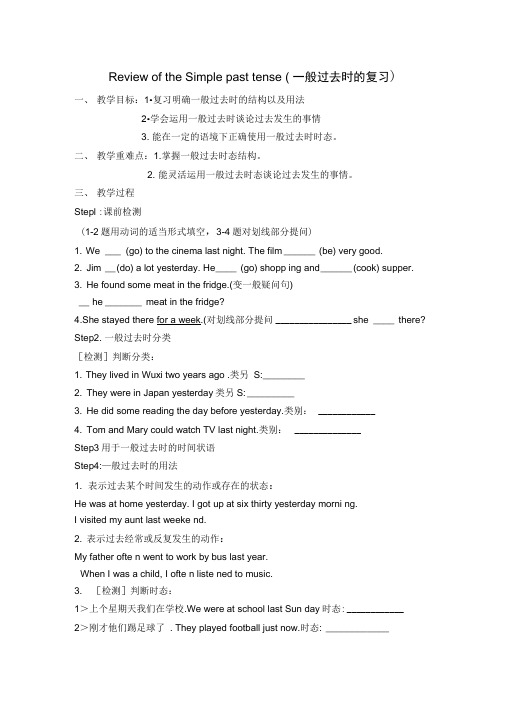
Review of the Simple past tense ( 一般过去时的复习)一、教学目标:1•复习明确一般过去时的结构以及用法2•学会运用一般过去时谈论过去发生的事情3. 能在一定的语境下正确使用一般过去时时态。
二、教学重难点:1.掌握一般过去时态结构。
2. 能灵活运用一般过去时态谈论过去发生的事情。
三、教学过程Stepl :课前检测(1-2题用动词的适当形式填空,3-4题对划线部分提问)1. We ___ (go) to the cinema last night. The film ______ (be) very good.2. Jim __ (do) a lot yesterday. He ____ (go) shopp ing and ______ (cook) supper.3. He found some meat in the fridge.(变一般疑问句)__ he _______ meat in the fridge?4.She stayed there for a week.(对划线部分提问________________ she ____ there? Step2. 一般过去时分类[检测]判断分类:1. They lived in Wuxi two years ago .类另S: ________2. They were in Japan yesterday类另S: _________3. He did some reading the day before yesterday.类别:____________4. Tom and Mary could watch TV last night.类别:______________Step3用于一般过去时的时间状语Step4:—般过去时的用法1. 表示过去某个时间发生的动作或存在的状态:He was at home yesterday. I got up at six thirty yesterday morni ng.I visited my aunt last weeke nd.2. 表示过去经常或反复发生的动作:My father ofte n went to work by bus last year.When I was a child, I ofte n liste ned to music.3. [检测]判断时态:1>上个星期天我们在学校.We were at school last Sun day时态: ____________2>刚才他们踢足球了. They played football just now.时态: ____________3>去年夏天他玩得高兴.He had a good time last summer. 时态:_____________4>当托尼还是个孩子的时候,他通常去公园玩游戏.When he was a child, Tony usually went to the park to play games. 时态:_____________Step5: be动词的过去时肯定句:主语+ be动词的过去式(was, were)~ .否定句:主语+ be动词的过去式(was, were)+ not ~一般疑问句:be动词的过去式(was, were)+主语~ ?1.1 was at school yesterday.(一般疑问句、否定回答)_______ at school yesterday? No, ________2. I was born on June 1st, 1999.(划线部分提问)__________ born ?3. There were some trees in my school.一般疑问句)__ there ___ trees in _____ school?Step6:情态动词的过去时:含有情态动词的一般过去时与含有Be动词的一般过去时,是十分相似,请注意观察。
一般过去时态复习教案

一般过去时态复习教案第一章:一般过去时态的定义和用法1.1 回顾一般过去时态的定义:表示过去某个时间发生的动作或存在的状态。
1.2 强调一般过去时态的用法:用于描述过去的事实、经历或习惯。
1.3 举例说明一般过去时态的构成:主语+ 动词过去式。
第二章:动词的过去式变化规则2.1 介绍动词过去式的变化规则:根据动词的词尾进行变化。
2.2 讲解规则动词的过去式:直接在动词原形后加上-ed。
2.3 讲解不规则动词的过去式:特殊变化形式,需单独记忆。
第三章:一般过去时态的时间状语3.1 介绍一般过去时态的时间状语:yesterday, today, tomorrow, last week, this morning等。
3.2 讲解时间状语与一般过去时态的搭配:使用时间状语来修饰动词的过去式。
3.3 举例练习:根据时间状语完成一般过去时态的句子。
第四章:一般过去时态的疑问句和否定句4.1 介绍一般过去时态的疑问句:将助动词did放在主语之前。
4.2 讲解一般过去时态的否定句:在主语后面加上did not(缩写为didn't)再加上动词原形。
4.3 举例练习:构造一般过去时态的疑问句和否定句。
第五章:一般过去时态的被动语态5.1 介绍一般过去时态的被动语态:was/were + 过去分词。
5.2 讲解主语和动词的关系:主语与动词之间是被动关系。
5.3 举例练习:将主动语态的一般过去时态句子转换为被动语态。
第六章:一般过去时态的日常生活应用6.1 强调一般过去时态在日常生活中的重要性。
6.2 举例说明一般过去时态在日常对话中的应用,如谈论昨天的事件、过去的习惯等。
6.3 角色扮演练习:学生模拟不同的日常情境,使用一般过去时态进行交流。
第七章:一般过去时态的文本阅读理解7.1 选取含有一般过去时态的短文或故事,让学生阅读。
7.2 设计阅读理解问题,要求学生用一般过去时态回答。
7.3 分析文本中的过去时态用法,讨论其表达的意义和效果。
小学一般过去时教案
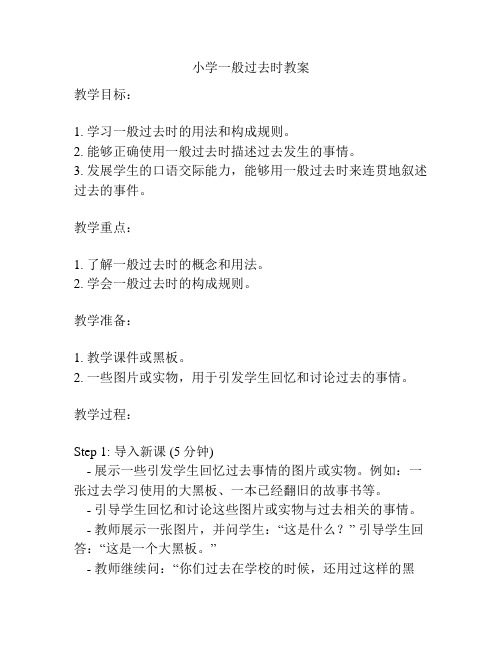
小学一般过去时教案教学目标:1. 学习一般过去时的用法和构成规则。
2. 能够正确使用一般过去时描述过去发生的事情。
3. 发展学生的口语交际能力,能够用一般过去时来连贯地叙述过去的事件。
教学重点:1. 了解一般过去时的概念和用法。
2. 学会一般过去时的构成规则。
教学准备:1. 教学课件或黑板。
2. 一些图片或实物,用于引发学生回忆和讨论过去的事情。
教学过程:Step 1: 导入新课 (5分钟)- 展示一些引发学生回忆过去事情的图片或实物。
例如:一张过去学习使用的大黑板、一本已经翻旧的故事书等。
- 引导学生回忆和讨论这些图片或实物与过去相关的事情。
- 教师展示一张图片,并问学生:“这是什么?” 引导学生回答:“这是一个大黑板。
”- 教师继续问:“你们过去在学校的时候,还用过这样的黑板吗?” 引导学生回答:“是的,我们过去在学校的时候用过这样的黑板。
”- 教师通过引导对话,让学生产生并回忆过去的经历和事件。
Step 2: 介绍一般过去时 (10分钟)- 教师通过回忆和引导学生的经历,向学生介绍一般过去时。
- 示范一般过去时的用法。
例如:“上周,我去了一趟海滩。
”- 解释一般过去时的构成规则:动词过去式的构成规则(例如:work → worked; play → played)。
Step 3: 练习一般过去时 (15分钟)- 教师提供一些句子,让学生根据句子中的提示词填写一般过去时的动词。
例如:“Yesterday, she _________ (dance) at the party.”- 教师引导学生展示他们填写的句子,并纠正他们的答案,确保他们理解一般过去时的用法和动词构成规则。
Step 4: 小组活动 (15分钟)- 教师将学生分成小组,让他们自己组织和讨论关于过去发生的事情,并用一般过去时来讲述。
- 每个小组派出一名代表来分享他们小组讨论的内容。
- 教师可以提供一些问题来引导学生讨论,例如:“你在过去做过什么有趣的事情?”,“你上个假期去过哪里?”等等。
一般过去时复习教案

一般过去时复习教案一、教学目标1. 让学生复习和巩固一般过去时的概念和用法。
2. 培养学生运用一般过去时进行交流和描述的能力。
3. 提高学生对英语时态的理解和运用。
二、教学内容1. 回顾一般过去时的定义和构成。
2. 分析一般过去时的用法和情景。
3. 练习运用一般过去时进行描述和交流。
三、教学方法1. 采用互动式教学,激发学生的学习兴趣和积极性。
2. 通过举例和练习,让学生理解和掌握一般过去时的用法。
3. 鼓励学生进行小组讨论和合作,提高口语交流能力。
四、教学步骤1. 导入:教师通过提问方式引导学生回顾一般过去时的定义和构成。
2. 新课内容:教师讲解一般过去时的用法和情景,举例说明。
3. 练习:学生进行小组讨论,用一般过去时描述过去的事件或经历。
4. 情景模拟:学生分组进行角色扮演,运用一般过去时进行对话。
5. 总结:教师对学生的表现进行点评,并强调一般过去时的重点和难点。
五、课后作业1. 学生回家后,用一般过去时写一篇小作文,描述一个过去的事件或经历。
2. 家长签字确认,监督学生的完成情况。
六、教学评价1. 评价方式:通过课堂表现、练习和课后作业对学生进行评价。
2. 评价内容:学生对一般过去时的理解、运用和口语表达能力。
3. 评价标准:能够正确使用一般过去时描述过去事件,发音准确,表达流畅。
七、教学资源1. 教学课件:用于展示一般过去时的定义、用法和例子。
2. 练习题库:用于课后练习和巩固所学内容。
3. 角色扮演道具:用于情景模拟和提高学生的参与度。
八、教学拓展1. 对比现在时和过去时的区别,让学生进一步理解时态的运用。
2. 引导学生思考一般过去时在实际生活中的应用,提高学生的实际运用能力。
3. 鼓励学生阅读以一般过去时为基础的英语文章,提高阅读理解能力。
九、教学建议1. 针对不同学生的学习程度,给予个性化的辅导和指导。
2. 鼓励学生多进行口语练习,提高表达能力。
3. 定期进行教学反思,调整教学方法和策略。
- 1、下载文档前请自行甄别文档内容的完整性,平台不提供额外的编辑、内容补充、找答案等附加服务。
- 2、"仅部分预览"的文档,不可在线预览部分如存在完整性等问题,可反馈申请退款(可完整预览的文档不适用该条件!)。
- 3、如文档侵犯您的权益,请联系客服反馈,我们会尽快为您处理(人工客服工作时间:9:00-18:30)。
一般过去时一、一般过去时表示在过去某个特定时间发生,或过去习惯性、经常性的动作。
一般过去时不强调动作对现在的影响,只说明过去的事情。
1. 表示过去发生的动作或存在的状态。
如:He bought the computer five years ago. 这电脑是他五年前买的。
It was then a small fishing village.那时它只是一个小渔村。
2.表示过去经常性或习惯性的动作。
如:We often played together when we were children.【注】表过去习惯性的动词,也可用used to或would。
如:He used to go to work by bus. 他过去常乘公共汽车去上班。
3. 常用于一般过去时的时间状语或从句连用。
(一般过去时最明显的现象就是常由表达过去之时间的副词或副词短语来修饰它)just now(刚才)yesterday(昨天)the day before yesterday(前天)、the other day = a few days ago(前几天)、before liberation(解放前…)、once upon a time(很久以前)、in the old days(过去的日子里)、yesterday (morning,afternoon,evening)(昨天早上/下午/晚上)That + 时间eg. That day (那天)时间+ ago… eg:two days ago(两天前)at+一个时间点、eg. at the age of 10 (过去年龄)段last + 时间eg. last:night/week/Sunday/weekend/month/winter/year/century世纪)、when引导的状语从句(过去时)eg.When I was 8 years old(当我八岁时…)、二.一般过去时的构成:1. 用动词的过去式。
作谓语的行为动词的词尾变化如下:2. 一般过去时态的肯定句、否定句和疑问句形式(1)基本结构主动:肯定句型① be 分为was,were ② v+ed否定句型① was/were not ②didn’t+v一般疑问句型① was/were+ 主② did+主+V特殊疑问句特殊疑问词+ 一般疑问句例句She often came to help us in those days.I didn't know you were so busy.(以be和like为例):(2)一般过去时态的“三变”技巧一变:肯定句变为否定句1当句中含有情态动词或助动词could,would,should等时,可直接在其后面加not构成否定句。
例如:I could get you a concert ticket.→ I could not / couldn't get you a concert ticket.2当句中含有系动词was,were 时,可直接在其后加not构成否定句。
例如:I was on the Internet when you called me.→ I was not / wasn't on the Internet when you called me.3当句中谓语是除情态动词、助动词、系动词was, were以外的动词时,在该动词之前加did not / didn't,动词还原,构成否定句。
例如:The famous singer sang some Chinese songs. → The famous singer did not / didn't sing any Chinese songs.二变:陈述句变为一般疑问句1移动词语的位置。
将was,were, could,would,should等移到句首。
例如:He could pack his things himself.→ Could he pack his things himself?2添加助动词did。
谓语是除情态动词、助动词、系动词was, were以外的动词时,在主语之前加did,动词还原。
例如:Mr Li looked very old.→ Did Mr Li look very old?三变:陈述句变为特殊疑问句1确定疑问词:人who / whom,物what,原因why 频率how often,长度how long,时间when / what time 距离how far等等。
例如:They gave the concert last night. 地点where,→ When did they give the concert?2辨认结构形式:疑问词+情态动词/助动词/ was / were / did +主语+...?例如:The accident happened near the station.→ Where did the accident happen?例题解析:1. Li Ming studied English this morning.(把此句变为一般疑问句)例题解析:1.Mr. Mott is out. But he ______ here a few minutes ago.A. wasB. isC. will beD. would be2. He promised to tell me by himself when I ______.A. comeB. would comeC. cameD. had come三、一般过去时表现在:1.过去”的概念并不是只指如“yesterday, last week,… ” 等,实际上“与现在对立的过去”,亦即“非现在的以前”,哪怕是“过了说话时间的几分钟之前”,只要所要表达的时间与说话时的“现在”形成对立,就必须使用一般过去时来表达。
例如:He was here only a few minutes ago.(仅仅几分钟前他还在这里。
)I didn’t know you were here. 我不知道你在这儿。
(were实际上指现在)I got up very early this morning.(今天早晨我起床很早。
)He was late for school again today.(今天他又迟到了。
)例题解析:---Hi, Tom. ---Hello, Fancy. I ______ you were here.A.don't knowB.won't thinkC. thinkD. didn't know2.在宾语从句中,由于时态呼应的关系,可用一般过去时表示现在。
如:I didn’t know you were here. 我不知道你在这儿。
(were实际上指现在)例题解析:I’m so sorry to disturb you, I didn’t know you _____ (be) so busy.3.表示客气委婉的现在。
如:I wondered if you were free this evening. 不知您今晚是否有空。
I thought you might like some flowers. 我想您也许想要些花。
【注】能这样有的动词主要限于want, wonder, think, hope, intend等少数动词。
3.用于某些特殊结构中表示现在It’s time we started. 我们该动身了。
I wish I knew his name. 要是我知道他的名字就好了。
I’d rather you lived closer to us. 我希望你能住得离我们近点。
【注】(1)该用法主要用于it’s time, I wish, I’d rather, if only, as if, as though 等少数结构后接从句的情形,(2)其中有些结构后面的句子还可用一般过去时表示将来。
4 如果强调已经终止的习惯时要用used to do(过去常常做,而现在不那样做了)He used to drink.他过去喝酒。
(意味着他现在不喝酒了。
喝酒这个动作终止了)I used to take a walk in the morning.我过去是在早晨散步。
(意味着现在不在早晨散步了)比较:I took a walk in the morning.我曾经在早晨散过步。
(只是说明过去这一动作)5 有些句子,虽然没有表示过去确定时间的状语,但实际上是指过去发生的动作或存在的状态的话,也要用过去时,这一点,我们中国学生往往出错,要特别注意!I didn''t know you were in Paris.我不知道你在巴黎。
(因为在说话时,我已经知道你在巴黎了。
这句话指的是说话之前,所以只能用过去时表示。
实际上,这句话暗指:But now I know you are here.)I thought you were ill.我以为你病了呢。
(这句话应是在说话之前,我以为你病了。
但是现在我知道你没病)基础练习一、写出下列动词的过去式is\am_________ fly_______ plant________ are ________ drink_________play_______ go________ make ________ does_________ dance________worry________ ask _____ taste_________ eat__________ draw________put ______ throw________ kick_________ pass_______ do ________have_______ become_______ grow_________ teach________ buy________二、用be动词的适当形式填空1. I ______ an English teacher now.2. She _______ happy yesterday.3. They _______ glad to see each other last month.4. Helen and Nancy ________ good friends.5. The little dog _____ two years old this year.6. Look, there ________ lots of grapes here.7. There ________ a sign on the chair on Monday.8. Today _____ the second of June. Yesterday ______ the first of June. It _____Children's Day. All the students ______ very excited.行为动词的过去时练习:1. He _________ (live) in Wuxi two years ago.2. The cat ________ (eat) a bird last night.3. We _______ (have) a party last Halloween.4. Nancy _______(pick) up oranges on the farm last week.5. I ________ (make) a model ship with Mike yesterday.6. They______ (play) chess in the classroom last PE lesson.7.My mother______(cook) a nice food last Spring Festival.8. The girls________(sing) and______(dance) at the party.9 We (not eat) apples yesterday.10 We (not play) basketball every day.11 He (not go ) home once a week.三、句型变换1 There was a car in front of the house just now.否定句:__________________________________________________________一般疑问句:__________________________________________________________ 肯定回答:__________________________________________________________ 否定回答:__________________________________________________________2 They played football in the playground.否定句:__________________________________________________________一般疑问句:__________________________________________________________ 肯定回答:__________________________________________________________ 否定回答:__________________________________________________________1、Lucy did her homework at home.(改否定句)Lucy ___________ ___________ her homework at home.2、He found some meat in the fridge(冰箱).(变一般疑问句)___________ he __________ ___________ meat in the fridge?3、She stayed there for a week.(对划线部分提问)__________ ___________ __________ she __________ there?4、There was some orange in the cup.(变一般疑问句)_________ there ___________ orange in the cup?四、选择1、I know a little bit about Italy as my wife and I ________ there several years ago.[2007 全国卷I]A. are goingB. had beenC. wentD. have been2、—Did you tidy your room? [2007 上海卷]— No, I was going to tidy my room but I ______ visitors.A. hadB. haveC. have hadD. will have3、—When I called you this morning, nobody answered the phone.---Where____ [2007 重庆卷]A. did you goB. have you goneC. were youD. had you been4、The play had already been on for quite some time when we ____ at the New Theatre. [2007 浙A. have arrivedB. arrivedC. had arrivedD. arrive5、“I ___ his telephone numbe r.” “I have his number, but I ___ to bring my phonebook.”A. forget, forgetB. forgot, forgotC. forget, forgotD. forgot, forget6. I had hoped to see her off at the station, but I _____ too busy.A. wasB. had beenC. would beD. would have been7. Dear me! Just _____ at the time! I _____ no idea it was so late.A. look, haveB. looking, hadC. look, hadD.looking, have8.“Your phone number again? I _____ quite catch it.” “It’s 4331577”A. didn’tB. couldn’tC. don’tD. can’t9、I don’t know if she _____, but if she ____ I will let you know.A. comes, comesB. will come, will comeC. comes, will comeD. will come, comes五、改错题(20)1.How is Jane yesterday? _____________________2.He go to school by bus last week. ____________________________3.He often goes home at 6:00 last month. ____________________________ 4.I can fly kites seven years ago. ______________________________5.Did you saw him just now. ____________________________________。
